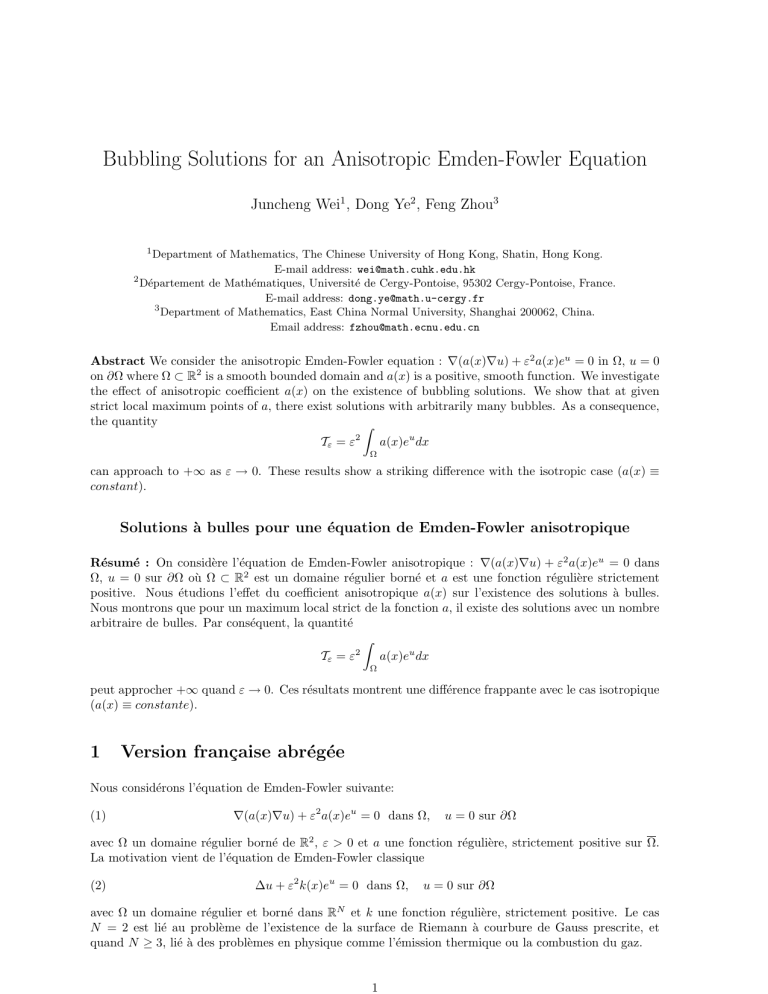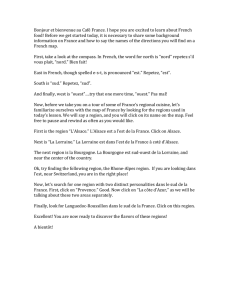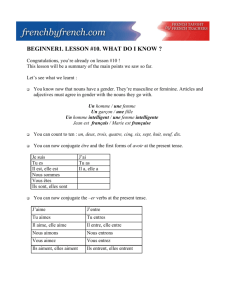Bubbling Solutions for an Anisotropic Emden-Fowler Equation Juncheng Wei , Dong Ye
advertisement

Bubbling Solutions for an Anisotropic Emden-Fowler Equation
Juncheng Wei1 , Dong Ye2 , Feng Zhou3
1
Department of Mathematics, The Chinese University of Hong Kong, Shatin, Hong Kong.
E-mail address: wei@math.cuhk.edu.hk
2
Département de Mathématiques, Université de Cergy-Pontoise, 95302 Cergy-Pontoise, France.
E-mail address: dong.ye@math.u-cergy.fr
3
Department of Mathematics, East China Normal University, Shanghai 200062, China.
Email address: fzhou@math.ecnu.edu.cn
Abstract We consider the anisotropic Emden-Fowler equation : ∇(a(x)∇u) + ε2 a(x)eu = 0 in Ω, u = 0
on ∂Ω where Ω ⊂ R2 is a smooth bounded domain and a(x) is a positive, smooth function. We investigate
the effect of anisotropic coefficient a(x) on the existence of bubbling solutions. We show that at given
strict local maximum points of a, there exist solutions with arbitrarily many bubbles. As a consequence,
the quantity
Z
Tε = ε2
a(x)eu dx
Ω
can approach to +∞ as ε → 0. These results show a striking difference with the isotropic case (a(x) ≡
constant).
Solutions à bulles pour une équation de Emden-Fowler anisotropique
Résumé : On considère l’équation de Emden-Fowler anisotropique : ∇(a(x)∇u) + ε2 a(x)eu = 0 dans
Ω, u = 0 sur ∂Ω où Ω ⊂ R2 est un domaine régulier borné et a est une fonction régulière strictement
positive. Nous étudions l’effet du coefficient anisotropique a(x) sur l’existence des solutions à bulles.
Nous montrons que pour un maximum local strict de la fonction a, il existe des solutions avec un nombre
arbitraire de bulles. Par conséquent, la quantité
Z
Tε = ε2
a(x)eu dx
Ω
peut approcher +∞ quand ε → 0. Ces résultats montrent une différence frappante avec le cas isotropique
(a(x) ≡ constante).
1
Version française abrégée
Nous considérons l’équation de Emden-Fowler suivante:
(1)
∇(a(x)∇u) + ε2 a(x)eu = 0 dans Ω,
u = 0 sur ∂Ω
avec Ω un domaine régulier borné de R2 , ε > 0 et a une fonction régulière, strictement positive sur Ω.
La motivation vient de l’équation de Emden-Fowler classique
(2)
∆u + ε2 k(x)eu = 0 dans Ω,
u = 0 sur ∂Ω
avec Ω un domaine régulier et borné dans RN et k une fonction régulière, strictement positive. Le cas
N = 2 est lié au problème de l’existence de la surface de Riemann à courbure de Gauss prescrite, et
quand N ≥ 3, lié à des problèmes en physique comme l’émission thermique ou la combustion du gaz.
1
note1.tex
April 13, 2006
2
Quand N = 2, le comportement asymptotique des solutions de (2) quand ε tend vers 0 est caractérisé
(voir [1, 10, 12, 8]) par celle de la quantité
Z
2
Tε = ε
k(x)euε dx.
Ω
Soit uε une famille de solutions telle que limε→0 Tε = l ∈ R+ ∪{∞} existe, alors l = 8πm avec m ∈ N∪{∞}.
∗
Si m = 0, limε→0 kuε k∞ = 0; si m = ∞, alors uε (x) → +∞ pour
P tout x ∈ Ω; et si m ∈ N , à sous suite
2
uε
prés, uε explose sur m points {xj } telle que ε k(x)e → 8π j δxj et (x1 , ..., xm ) est un point critique
d’une fonctionnelle liée à la fonction de Green du domaine Ω. Réciproquement, des solutions explosives
ont été construites (voir [2, 5, 7]). En particulier dans [5], ils montrent que si Ω est non simplement
connexe, alors des solutions à m bulles existent pour n’importe quel m ∈ N∗ . Peu de résultats existent
pour (2) si N ≥ 3.
Notre motivation ici est double. Premièrement, l’équation (2) semble être une généralisation naturelle
de (1), on pouvait espérer que des résultats similaires restent valables, nous allons voir pourtant que ce
n’est pas le cas. Deuxièmement, l’équation (2) se transforme en (1) dans un cas particulier en dimension
supérieure. En effet, si on cherche une solution à la symétrie rotationnelle sur un tore standard de RN ,
l’équation (2) se transforme en (1) avec a(r, z) = rN −2 . Dans [13], il est montré que si limε→0 Tε = l ∈
]0, ∞[ existe, alors l ∈ 8πN∗ et à sous suite prés, uε explose sur un ensemble fini S = {x1P
, . . . , xm } ⊂ Ω. En
plus, uε → u∗ faiblement dans W01,p pour tout p ∈ ]1, 2[ où u∗ satisfait ∇(a∇u∗ ) + 8π i mi a(xi )δxi = 0
dans Ω, mi ∈ N∗ et xi sont des points critiques de la fonction a dans Ω. Ils ont construit aussi une famille
de solutions avec un bulle dans le cas de symétrie radiale.
Plusieurs questions importantes restent ouvertes : peut on avoir mi > 1 ou toutes les bulles sont
simples? Comment peut on construire des solutions à bulles dans le cas général de a et de Ω? Les
résultats suivants sont des réponses correspondantes à ces deux questions.
Théorème 1 Soit x̄ ∈ Ω un maximum local strict de a, i.e. ∃ δ > 0 tel que a(x) < a(x̄) pour tout
x ∈ Bδ (x̄)\{x̄}. Alors ∀ m ∈ N∗ , (1) admet une famille de solutions uε telle que quand ε → 0+ ,
Z
2
Tε = ε2
a(x)euε → 8πma(x̄), uε → u∗ dans Cloc
(Ω\{x̄})
Ω
∗
où −∇(a(x)∇u ) = 8πma(x̄)δx̄ dans Ω et u∗ = 0 sur ∂Ω. Plus précisément,
"
#
m
X
1
ε
(3)
uε (x) =
log 2 2
ε |2 )2 + H(x, ξj ) + o(1)
(ε
µ
+
|x
−
ξ
j
j
j=1
avec H la partie régulière de la fonction de Green G associée à l’opérateur −∆a = −a(x)−1 ∇ (a(x)∇·)
et à la condition de Dirichlet au bord. En plus,
1
≤ µj ≤ | log ε|C ,
C
lim ξjε = x̄
ε→0
et
|ξiε − ξjε | > | log ε|−
m2 +1
2
, ∀ i 6= j.
Théorème 2 Soit x̄ ∈ Ω un point critique topologiquement non trivial de a (voir la définition dans [6]
ou dans la version en anglais), alors pour ε > 0 suffisamment petit, le problème (1) admet des solutions
uε telle que
Z
a(x)euε → 8πa(x̄),
ε2
Ω
∗
uε → u∗
dans
2
Cloc
(Ω̄\{x̄}),
où u∗ satisfait −∇(a(x)∇u ) = 8πa(x̄)δx̄ dans Ω, u∗ = 0 sur ∂Ω.
Théorème 1 montre que l’accumulation des bulles peut apparaı̂tre dans le cas anisotropique même pour
Ω simplement connexe, c’est assez surprenant car cela n’a pas lieu pour l’équation (2) (Un tel phénomène
est possible seulement si la condition au bord est quelconque, voir [4]), et nous savions également par
[13] que si x̄ est un minimum local non dégénéré de a, alors m = 1. Dans le cadre du Théorème 1, par
un processus de diagonale, on peut avoir une suite de solution uε telle que Tε peut tend vers ∞, cela se
contraste aussi avec l’équation (2), pour laquelle Tε reste borné si Ω est simplement connexe (voir [9]).
note1.tex
April 13, 2006
3
Notre preuve utilise la méthode de l’énergie localisée, qui est une combinaison de la réduction de
Liapunov-Schimidt et de la technique variationnelle. En fait, nous réduisons la résolution de (1) à un
problème en dimension finie associée à une énergie réduite, et les solutions dans Théorèmes 1 et 2 sont
générées comme des points critiques de l’énergie réduite. Ce genre de technique a été utilisé récemment
dans beaucoup de travail. Ici nous allons suivre l’approche dans [5]. Notre situation est pourtant plus
délicate, car les distances entre les différents bulles vont tendre vers zéro, ce qui nous oblige à bien étudier
leurs intéractions et rend l’analyse plus difficile. Nous avons développé donc de nouveaux arguments pour
établir un cadre fonctionnel convenable. Le détail de nos preuves se trouve dans [11].
2
Introduction
We consider the following generalized Emden-Fowler equation
∇(a(x)∇u) + ε2 a(x)eu = 0 in Ω,
(4)
u = 0 on ∂Ω
where Ω ⊂ R2 is a bounded smooth domain, ε > 0 and a(x) is a smooth positive function over Ω.
Equation (4) was motivated by the study of the following Emden-Fowler equation, or Gelfand’s equation
∆u + ε2 k(x)eu = 0 in Ω,
(5)
u = 0 on ∂Ω
where Ω ⊂ RN is a bounded and smooth domain. When N = 2, (5) relates to the geometric problem of
Riemannian surfaces with prescribed Gaussian curvature. When N ≥ 3, it was also arised in the theory
of thermionic emission, isothermal gas sphere, gas combustion and many other physical applications.
When N = 2, the asymptotic behavior of solutions to (5) has been studied in [1, 8, 10, 12]. Let
Z
2
Tε = ε
k(x)euε dx,
Ω
suppose maxx∈Ω uε → +∞. Then along a subsequence of solutions uε , Tε tends to l as ε → 0, there
∗
holds either l = ∞, uε (x) → +∞ for all x ∈ Ω; or l = 8πm with
P m ∈ N and uε makes m points (simple)
2
uε
blow-up on S = {x1 , ..., xm } ⊂ Ω such that ε k(x)e → 8π j δxj . Conversely, many authors have tried
to construct blow-up solutions, see [2, 5, 7].
Our motivation here are two-folds. First, equation (4) is a natural generalization of (5). One may
expect similar results hold, but this is not true as we will show below. Secondly, in some special case,
equation (5) in higher-dimension (N ≥ 3) can be reduced to (4), for example, when we work with the
cross-section of a N-dimensional torus having axial symmetry. In [3], Chanillo & Li studied (4) (and
more general uniformly elliptic type problems) and generalized the Brezis-Merle results to (4). In [13],
Ye & Zhou studied the asymptotic behavior of bubbling solutions to (4). They proved that if Tε tends to
l ∈ (0, ∞), then there exists a finite set S =P{x1 , ..., xm } ⊂ Ω such that uε → u∗ weakly in W01,p for any
p ∈ (1, 2), where u∗ satisfies ∇(a∇u∗ ) + 8π i mi a(xi )δxi = 0 in Ω and mi ∈ N∗ . Moreover, they proved
that each xi must be a critical point of a. In the case of Ω = B1 (0), a = a(|x|), they also constructed a
single blowing up family of radial solutions.
Several important questions have been left open: can we have mi > 1, or are all the bubbles simple?
How do we construct bubbling solution for the general (non-radial) a and Ω? In this note, we answer
these two questions affirmatively. Our results are the following
Theorem 1 Let x̄ ∈ Ω be a strict local maximum point of a(x), i.e., there exists a neighborhood Bδ (x̄)
such that a(x) < a(x̄), ∀ x ∈ Bδ (x̄)\{x̄}. Then for any m ∈ N∗ , problem (4) has a family of solutions uε
such that as ε → 0+ ,
Z
2
a(x)euε → 8πma(x̄), uε → u∗ in Cloc
(Ω\{x̄})
Tε = ε2
Ω
∗
∗
where u satisfies −∇(a(x)∇u ) = 8πma(x̄)δx̄ in Ω, u∗ = 0 on ∂Ω. More precisely, we have
"
#
m
X
1
ε
(6)
uε (x) =
log 2 2
+ H(x, ξj ) + o(1)
(ε µj + |x − ξjε |2 )2
j=1
note1.tex
April 13, 2006
4
where H is the regular part of Green’s function associated to the operator −∆a and the Dirichlet boundary
condition (see Lemma 3.1). We have also
1
≤ µj ≤ | log ε|C ,
C
ξjε → x̄
|ξiε − ξjε | > | log ε|−
and
m2 +1
2
, ∀ i 6= j.
Let D be an open set in Ω. Following [6], we say a(x) has a “topologically nontrivial critical point”
at critical level c relative to B and B0 if B and B0 are closed subsets of D with B connected and B0 ⊂ B
such that the following conditions hold: let Γ be the class of all maps Φ ∈ C(B, D) with the property
that there exists a function Ψ ∈ C([0, 1] × B, D) such that Ψ(0, ·) = IdB , Ψ(1, ·) = Φ, Ψ(t, ·)|B0 = IdB0
for all t ∈ [0, 1]. We assume that
sup a(y) < c = inf sup a(Φ(y))
y∈B0
Φ∈Γ y∈B
and for all y ∈ ∂D such that a(y) = c, there exists a vector τy tangent to ∂D at y verifying ∇a(y) · τy 6= 0.
Under these conditions, a critical point ȳ ∈ D of a(x) with a(ȳ) = c exists. We call c a nontrivial critical
level of a in D. It is easy to see that local maximum points, local minimum points, nondegenerate critical
points of a are all “topologically nontrivial”. We have then
Theorem 2 Let x̄ ∈ Ω be a topologically nontrivial critical point of a. Then for ε > 0 sufficiently small,
problem (4) has solutions uε such that
Z
2
ε2
a(x)euε → 8πa(x̄), uε → u∗ in Cloc
(Ω̄\{x̄}),
Ω
where u∗ satisfies −∇(a(x)∇u∗ ) = 8πa(x̄)δx̄ in Ω, u∗ = 0 on ∂Ω.
It is quite surprising that accumulation of bubbles can occur for anisotropic Emden-Fowler equation
even for Ω simply connected. The only known result for such phenomena is due to [4]. In [13], it is
shown that if x̄ is a nondegenerate local minimum point of a, then m = 1. Here we show that if x̄ is a
strict local maximum point, then we can allow arbitrary m > 1. A consequence of Theorem 1 is that if
a has a strict local maximum in Ω, then there exist solutions uε such that Tε → +∞. This is new and
unexpected, since when Ω is simply connected, it was shown in [9] that Tε is uniformly bounded for (5).
Theorems 1 and 2 are proved via the so-called “localized energy method”- a combination of LiapunovSchmidt reduction method and variational techniques. Namely, we first use Liapunov-Schmidt reduction
method to reduce the problem to a finite dimensional one, with some reduced energy. Then, the solutions
in Theorems 1 and 2 turn out to be generated by critical points of the reduced energy functionals. Such an
idea has been used in many other papers. Here we follow those of [5]. However, a new functional setting
has to be introduced, since the distance between the bubbles is small, and an appropriate variational
argument is developed in order to make the approach successful. In what follows, we shall sketch the
proof for Theorem 1 since that of Theorem 2 is simpler and follows from the proof of Theorem 2 in [5],
so we omit the details. We can also prove that the flatter the anisotropic coefficient is, the larger are the
distances between the bubbles.
3
3.1
Sketch of the proof of Theorem 1
Ansatz for the solution
Given ξj ∈ Ω, µj > 0, we define
uj (x) = log
(ε2 µ2j
8µ2j
.
+ |x − ξj |2 )2
It is well known that −∆uj = ε2 euj in R2 . We take the configuration space for (ξ1 , ..., ξm ) as follows
½
¾
¯
1
¯
(7)
Λ := ξ = (ξ1 , ..., ξm ) ∈ Bδ (x̄) × ... × Bδ (x̄)¯ min |ξi − ξj | ≥
i6=j
| log ε|M
note1.tex
April 13, 2006
5
£
¤
P
where M = (m2 + 1)/2 and the choice of µj will be made later on. Uξ (x) = 1≤j≤m uj (x) + Hjε (x)
is our ansatz where Hjε is a correction term defined as the solution of ∆a Hjε + ∇ log a(x)∇uj = 0 in Ω,
Hjε = −uj on ∂Ω. The behavior of Hjε is given by
¢
¡
Lemma 3.1 For any 0 < α < 1, Hjε (x) = H(x, ξj ) − log 8µ2j + O(εα ) uniformly in Ω, where H(x, y) =
G(x, y) + 4 log |x − y| with G the Green’s function
−∆a G(x, y) = −
1
∇ [a(x)∇G] = 8πδ(x − y) in Ω,
a(x)
G(x, y) = 0 on ∂Ω.
Define V (y) = Uξ (εy) + 4 log ε, we will seek a solution v of the form v = V + φ, the problem (4) can
be stated as to find φ a solution to
∆a(εy) φ + eV φ + N (φ) + R = 0 in Ωε , φ = 0 on ∂Ωε ,
where Ωε = {y ∈ R2 , εy ∈ Ω}, the nonlinear term is N (φ) = eV (eφ − 1 − φ) and the error term is given
by R = ∆a(εy) V + eV . We choose µj by
X
¡
¢
log 8µ2j = H(ξj , ξj ) +
G(ξi , ξj ), ∀ 1 ≤ j ≤ m,
i6=j
so that we make the error term R small and W = eV well controlled. Observe that µj is not O(1) since
ξj → x̄ implies that lim G(ξi , ξj ) = ∞. But we can derive that C1 ≤ µj ≤ | log ε|C for some fixed C > 0.
3.2
Solvability of linear and nonlinear equations
A key step of our proof is to consider the following linear problem: Given h ∈ L∞ (Ωε ), find φ, c11 , ..., c2m
such that
m
2
1 XX
cij χj Zij in Ωε
−∆
φ
=
W
φ
+
h
+
a(εy)
a(εy) j=1 i=1
(8)
φ=0
Z
χj Zij φ = 0,
on ∂Ωε
∀ 1 ≤ j ≤ m, i = 1, 2
Ωε
0
0
where Zij (y) = zij (y − ξj ) with ξj = ξj /ε and
yi
, 1 ≤ i ≤ 2, 1 ≤ j ≤ m.
µ2j + |y|2
³
´
|y−ξj0 |
Moreover χj are defined as χj (y) = χ
with χ a suitable cut-off function. The problem is solvable
µj
for all small ε > 0. We have
zij =
Proposition 3.2 Let m be a positive integer. Then there exist ε0 > 0, C > 0 such that for any 0 < ε <
ε0 , any family of points (ξ1 , . . . , ξm ) ∈ Λ and any h ∈ L∞ (Ωε ), there is a unique solution φ ∈ L∞ (Ωε ),
cij ∈ R to (8). Moreover, kφkL∞ (Ωε ) ≤ C| log ε|khk∗ .
Here khk∗ denotes the following norm
khk∗ = sup
y∈Ωε
ε2 +
|h(y)|
³
−2
1+
µ
j=1 j
Pm
1
µj |y
− ξj0 |
´−3 .
The proof is rather involved since the distance between different bubbles is small and the constants µj
are no longer bounded when ε tends to zero, so we need to well control their interaction. The result of
Proposition 3.2 implies that the unique solution φ = T (h) of (8) defines a continuous linear map from
the Banach space C∗ of L∞ (Ωε ) endowed with the norm k · k∗ into L∞ . Using the differentiability of the
operator T with respect to the variables ξj0 , we get then
note1.tex
April 13, 2006
6
Lemma 3.3 Let m ∈ N∗ and α ∈ (0, 1). Consider the nonlinear equation with h = R + N (φ) in (8).
Then there exist ε0 > 0, C > 0 such that for any 0 < ε < ε0 and any (ξ1 , . . . , ξm ) ∈ Λ the nonlinear
problem φ = T (R+N (φ)) admits a unique solution φ, cij such that kφkL∞ (Ωε ) ≤ Cεα | log ε|. Furthermore,
the function ξ 0 7→ φ(ξ 0 ) is of class C 1 and kDξ0 φkL∞ (Ωε ) ≤ C εα | log ε|3 .
3.3
Variational reduction
Given ξ = (ξ1 , . . . , ξm ) ∈ Λ, we define φ(ξ) and cij (ξ) to be the unique solution given by Lemma 3.3. Set
Fε (ξ) = Jε (Uξ + φ̃(ξ)) where Jε is the functional defined by
Z
Z
1
2
2
Jε (v) =
a(x)|∇v| dx − ε
a(x)ev dx
2 Ω
Ω
¡
¢
and φ̃(ξ)(x) = φ ε−1 x, ε−1 ξ for x ∈ Ω. With the estimate of Lemma 3.3, we can prove
Lemma 3.4 If ξ = (ξ1 , . . . , ξm ) ∈ Λ is a critical point of Fε then u = U (ξ) + φ̃(ξ) is a critical point of
Jε , that is, a solution to (4).
We get also the uniform closeness of Fε (ξ) and Jε (U (ξ)) as Fε (ξ) = Jε (U (ξ))+θε (ξ) where kθε kC 1 (Λ) → 0
when ε tends to 0. For proving Theorem 1, we use the uniform energy expansion over Λ
Jε (U ) = −16π
m
X
j=1
a(ξj ) log ε − 4π
X
i6=j
a(ξj )G(ξi , ξj ) − 4π
X
a(ξj )H(ξj , ξj ) + O(1).
j
Finally, some suitable upper and lower bound estimates lead us to claim that the maximization problem
max(ξ1 ,...,ξm )∈Λ̄ Fε (ξ1 , ..., ξm ) has a solution in the interior of Λ, hence guarantees the existence of a
critical point of Fε , and then a solution uε for (4) by Lemma 3.4. Furthermore, from the ansatz and the
decomposition of uε , we get easily the rest of the properties of uε .
Acknowledgments The research of J.W. is supported by an Earmarked Grant from RGC of Hong
Kong (RGC 402503). F.Z. is supported in part by NNSF No. 10231010 of China and Shanghai Priority
Academic Discipline. Part of this work was done while D.Y. and F.Z. were visiting the Chinese University
of Hong Kong, they would like to thank the department of Mathematics for its warm hospitality.
References
[1] H. Brezis, F. Merle, Uniform estimates and blow-up behavior for solutions of −∆u = V (x)eu in two
dimensions. Comm. P.D.E. 16 (1991), no. 8-9, 1223-1253.
[2] S. Baraket, F. Pacard, Construction of singular limits for a semilinear elliptic equation in dimension
2. Calc. Var. P.D.E. 6 (1998), no. 1, 1–38.
[3] S. Chanilo and Y.Y. Li, Continuity of solutions of uniformly elliptic equations in R2 , Manuscripta
Math. 77 (1992), 415-433.
[4] X. Chen, Remarks on the existence of branch bubbles on the blowup-analysis of equation −∆u = e2u
in dimesnion two, Comm. Anal. Geom. 7 (1999), 295-302.
[5] M. Del Pino, M. Kowalczyk and M. Musso, Singular limits in Liouville-type equations. Calc. Var.
P.D.E. 24 (2005), 47-81.
[6] M. Del Pino and P. Felmer, Semiclassical states for nonlinear Schrodinger equations, J. Funct. Anal.
149 (1997), 245-265.
[7] P. Esposito, M. Grossi, A. Pistoia, On the existence of blowing-up solutions for a mean field equation.
Ann. I.H.P. Anal. Nonlinéaire 22 (2005), 227–257.
note1.tex
April 13, 2006
7
[8] L. Ma and J. Wei, Convergence for a Liouville equation, Comm. Math. Helv. 76 (2001), 506-514.
[9] N. Mizoguchi and T. Suzuki, Equations of gas combustion: S−shaped bifurcation and mushrooms,
J. Diff. Eqns. 134 (1997), 183-215.
[10] K. Nagasaki, Y. Suzuki, Asymptotic analysis for two-dimensional elliptic eigenvalue problems with
exponentially dominated nonlinearities, Asymptotic Anal. 3 (1990), 173-188.
[11] J. Wei, D. Ye and F. Zhou, Bubbling Solutions for an Anisotropic Emden-Fowler Equation, to appear
in Calc. Var. P.D.E. (2006).
[12] D. Ye, Une remarque sur le comportement asymptotique des solutions de −∆u = λf (u), C.R. Acad.
Sci. Paris, I 325 (1997), 1279-1282.
[13] D. Ye and F. Zhou, A generalized two dimensional Emden-Fowler equation with exponential nonlinearity, Calc. Var. P.D.E. 13 (2001), 141-158.




